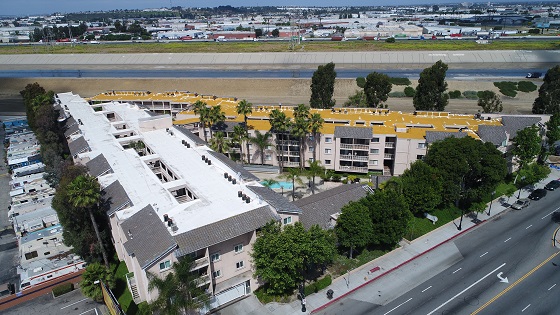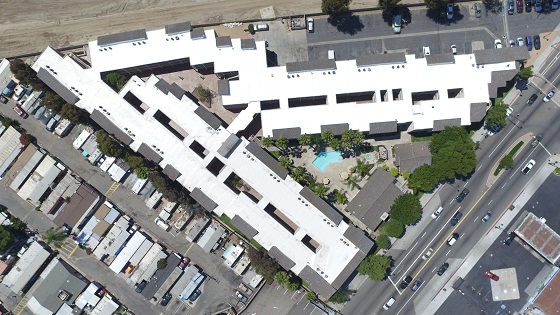According to a recent study, entitled “Interacting Implications of Climate Change, Population Dynamics, and Urban Heat Mitigation for Future Exposure to Heat Extremes,” heat waves are likely to become more and more frequent across California by 2050. A press release regarding the study states, “If cool roofs were adopted throughout California’s most populous areas — the San Francisco Bay Area, Los Angeles, San Diego, and Sacramento — by 2050 these reflective roofs could bring down heat wave exposures (defined as each time a person experiences a heat wave) by 35 million each year, compared to an estimated 80 million heat wave cases in 2050 with no increase in cool roof adoption.”
Cool roofing and reflective roofs often involve coatings. Javier Chavez, owner of American High Tech Roof Coating, Inc. (AHTRCI), based in Los Angeles, has been applying such coatings since 1997. In the summer of 2018, Chavez and his crew helped to restore a roof in nearby Long Beach, California, by applying a cool roof silicone coating.
Trusted Products
The Windmill Creek Apartments complex in Long Beach consists of 139 units in a large, V-shaped building topped by a 60,000-square-foot (5,574.2 m
2) roof. When the building owner asked Chavez to provide an estimate, Chavez noted that the 23-year-old, built-up flat roof was in good condition and was suitable for a roof coating. Upon winning the job through a bidding process, he chose EVERROOF’s Ever-Silic cool roof maintenance coating system, a high-solids, elastomeric silicone coating that provides superior water and ultraviolet (UV) resistance over a variety of roof substrates.
Chavez has been using EVERROOF products for the past four or five years. “They are owned by Polycoat,” he explained, “and I’ve been using Polycoat since 1997. This company has spent years developing waterproofing coatings, so I trust them.”
Nearly all of AHTRCI’s 10 employees worked on the job in Long Beach for two months, finishing in July. There were a few delays due to unexpected rain, but otherwise the job went according to plan. To ensure everyone’s safety on the roof, warning lines were placed around the location of the project in the form of small flags and cones. The parapet walls along the roof’s perimeter made harnesses and lanyards unnecessary. In addition, the crew wore gloves, long-sleeved shirts, safety glasses, hats, and 3M vapor respirator masks.

They did not need hard hats, per Chavez, because there was no construction above them. However, they did wear sombreros. “A roofer understands,” said Chavez, “as soon as you’re up on a roof, you get the biggest sombrero you can get. It gets brutal. It gets hot.”
By the Book
The AHTRCI crew started the project by washing off the roof with four DEWALT 3,400-psi (23.4 MPa) pressure washers. “After you decide that you can do coatings on a roof,” Chavez pointed out, “you have to power wash the entire roof. After power washing, you have to let it dry for 24 to 48 hours, depending on the weather. If you have a cloudy day, you have to wait, because the roof has granules and holds a lot of water.” Following the pressure washing, the crew made small sealing repairs to the roof.
Although California has regulations for water reclamation, in this case there was no need to collect the water from the pressure washing step because the water was not contaminated in any way. “It’s not that much water,” explained Chavez. “It’s a very small amount of water with a lot of pressure. You don’t waste that much water.”
Also in step with California regulations, EVERROOF’s Ever-Silic coatings are considered “qualified products” under California law. Chavez elaborated, “California is one of the hotter states to work with coatings. For example, if you have a coating in Texas, you cannot necessarily use it in California. It has to meet the VOCs [volatile organic compounds] for California. EVERROOF is a low-VOC product. This is a 100 percent silicone product, but it qualifies for all the regulations from California.”
Big Rig for a Big Job
Once the surface was prepared, AHTRCI began applying the EVERROOF Primer M100, a two-part epoxy mixed at a 4:1 ratio. This was spray applied using a Speeflo 10,000 (owned by Titan Tool) — what Chavez referred to as “the big rig.” It’s a gasoline-operated machine from which he ran two 100-foot (30.5 m) linear hoses. “I used a big rig because it was a big job and it was a lot of primer,” said Chavez. “I had four guys operating the machine. You don’t want to bring this machine to a 5,000-square-foot [464.5 m2] job, because people are going to laugh. It’s a huge machine.”
One coat of primer was applied at 0.5 gallon per 100 square feet (1.9 L/9.3 m2), which equates to a wet film thickness (WFT) of approximately 7.5 mils (190.5 microns). “It took us probably between four and six working days to apply the primer,” recalled Chavez. “Because this roof is in a V shape, I started with one side doing the primer. The primer dries in about one or two hours. So right after my primer was dry, I had my other four guys doing patching, or what is called the mastic.”
EVERROOF’s Ever-Silic RF (Roof Flashing) silicone mastic was applied with 3-inch (76.2 mm) brushes, and EVERROOF Ever-Fabric 4- or 6-inch (101.6 or 152.4 mm) polyester reinforcement fabric was incorporated to reinforce any weak patches in the mastic, potential leaks, or overlaps.
Once the mastic was dry, which took a couple of days, “we started coating,” Chavez said. “We used squeegees and backrollers for the whole topcoat. The reason I didn’t use a spray machine is because it’s a tall building. It’s heavy equipment to bring it up.” Two coats of silicone — EVERROOF’s Ever-Silic HS (High Solids) 100 percent silicone — were applied at 2.5 gallons per 100 square feet (9.5 L/9.3 m2) each in order to comply with the manufacturer’s specs and achieve the warranty. This equates to approximately 37.5 mils (952.5 microns) WFT for each topcoat layer.
Chavez said the owner of the Windmill Creek Apartments was pleased with the coatings work performed by AHTRCI. This California apartment building, situated in one of the more populous areas of one of the hottest U.S. states, now has a cool roof that will last for years to come. That’s a great way to help beat the heat!
